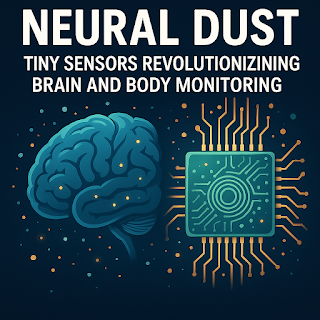Neural Dust: Tiny Wireless Sensors That Monitor Brain and Body
Imagine microscopic sensors, small enough to float through your bloodstream, silently monitoring your nerves, muscles, or brain activity in real time. These aren't science fiction—they're real, and they are called Neural Dust. This groundbreaking technology is one of the most promising advancements in bioelectronics and biomedical engineering. But what exactly is neural dust, how does it work, and what are its implications for the future of healthcare and neuroscience?
🔍 What is Neural Dust?
Neural dust refers to millimeter-sized, wireless sensors that can be implanted into the human body, especially the nervous system and brain. These tiny devices can monitor electrical activity from nerves and muscles and communicate this data wirelessly to external devices. Unlike traditional implants that require batteries or large hardware, neural dust is small, self-powered, and minimally invasive.
First introduced in 2016 by researchers at the University of California, Berkeley, neural dust has since evolved into one of the leading contenders in the race to develop next-generation neural interfaces.
🧬 How Does Neural Dust Work?
Each neural dust mote contains a piezoelectric crystal, which generates electricity when subjected to ultrasound. Here's how it works in simple terms:
- An external ultrasound device sends sound waves into the body.
- The piezoelectric crystal in the dust converts the ultrasound into electricity.
- This energy powers tiny sensors that record electrical signals from neurons or muscles.
- The data is transmitted back using modulated ultrasound waves.
This method allows for completely wireless monitoring, removing the need for wires that traditionally pierce the skin and risk infection or damage.
🏥 Applications in Medicine
Neural dust has the potential to revolutionize how we monitor, diagnose, and treat a wide variety of medical conditions.
🔹 Neurological Monitoring
Doctors could use neural dust to track electrical signals in the brain continuously. This could lead to better understanding and treatment of conditions like epilepsy, Parkinson's disease, and traumatic brain injury.
🔹 Chronic Disease Management
For people with diabetes, neural dust could monitor insulin levels or nerve function. For heart patients, it might track muscle performance or detect arrhythmias early.
🔹 Prosthetics and Paralysis
Implanted neural dust near muscles or spinal cord nerves could help paralyzed patients regain control over limbs using brain-controlled prosthetics.
🤖 Integration with AI and Brain Interfaces
Neural dust also plays a key role in the development of Brain-Computer Interfaces (BCIs). By collecting high-resolution data from the brain or nervous system, these devices can feed rich, real-time data into AI systems for analysis and control.
Imagine a future where your thoughts control not just a prosthetic arm but your smartphone, computer, or even your car. Neural dust brings us a step closer to such possibilities by offering a high-bandwidth, minimally invasive way to read brain signals.
🔬 How It Compares to Other Technologies
Compared to traditional electrode implants or wearable devices, neural dust offers several key advantages:
- Size: Neural dust motes are just 1mm or smaller, making them far less invasive.
- Longevity: With no batteries, they can last indefinitely once implanted.
- Wireless: No need for wires or direct power sources reduces infection risks.
However, there are challenges, too. Manufacturing such small and reliable devices is technically complex. Also, their long-term safety and compatibility with the body must be proven through extensive testing.
⚠️ Ethical and Privacy Concerns
As with any technology that interfaces with the human body—especially the brain—there are important ethical questions:
- Who owns the data collected from your nervous system?
- Can these devices be hacked?
- Should people be allowed to implant them for cognitive enhancement?
Regulations and global health policies will play a vital role in shaping how neural dust is used and who can access it. Discussions around privacy, consent, and long-term biological impacts are already underway.
🌍 The Future of Neural Dust
The possibilities with neural dust are vast and still unfolding:
- Full-body monitoring: Imagine a network of dust motes throughout the body providing real-time health analytics.
- Neural mapping: Scientists could create detailed maps of brain activity for research and treatment.
- Bioelectronic medicine: Devices that treat diseases by stimulating specific nerves or organs directly.
As computing becomes smaller and more powerful, neural dust could eventually lead to “smart bodies” — humans enhanced by a swarm of invisible sensors, silently improving our health and capabilities.
🔍 Conclusion
Neural dust represents one of the most exciting developments in modern science. It combines the frontiers of nanotechnology, neuroscience, artificial intelligence, and bioengineering to create something truly revolutionary. With its potential to transform healthcare, human performance, and even the way we connect with machines, neural dust is much more than a scientific curiosity — it’s a preview of the future.
As research continues, neural dust may help us better understand ourselves, heal previously untreatable conditions, and bridge the gap between biology and technology. It truly is science made simple, and extraordinary.
Tags: Neural Dust, Wireless Brain Sensors, Brain-Computer Interface, Future of Medicine, Nanotechnology, AI and Neuroscience



Comments
Post a Comment